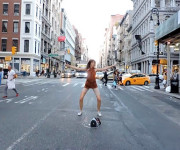Carnegie Mellon University will create a new facility that will more than double its gallery space for the Miller Institute for Contemporary Art (ICA) in a prominent new location thanks to a $15 million commitment from the Juliet Lea Hillman Simonds Foundation and the Henry L. Hillman Foundation.

In 2018, the ICA presented an exhibition titled “Paradox: The Body in the Age of AI,” which featured this virtual reality installation by artist Claudia Hart. Photo – courtesy of Carnegie Mellon College of Fine Arts ©
The new ICA will be a civic and cultural component of the new Richard King Mellon Hall of Sciences, a collaborative, multidisciplinary building for education and research that is expected to begin construction next year. In this new location at the intersection of Forbes Avenue and Craig Street in the Oakland cultural district, the ICA will expand access and visibility to the public, diversify its programming, enhance its resources as an educational space for CMU students, create new synergies with the Carnegie Museums of Pittsburgh, and contribute to the vibrancy of the neighbourhood.
“CMU’s Institute for Contemporary Art is one of the university’s jewels and symbolizes our commitment to fueling artistic and creative expression, and sparking opportunities to make meaning of contemporary life by engaging with the art of our time,” said Farnam Jahanian, president of Carnegie Mellon University. “We are grateful that the ICA will reach new audiences and have an increased impact through the vision and continuing support of the Henry L. Hillman Foundation and Lea Simonds, a pillar of the Pittsburgh cultural community and a beloved member of our Tartan family.”
A Carnegie Mellon trustee since 2004, Simonds also is a member of the College of Fine Arts Dean’s Council. In addition, she serves on the boards of the Carnegie Museum of Art, City of Asylum, and Pittsburgh Chamber Music Society; is a life trustee of the Carnegie Museums of Pittsburgh, and is an emerita member of the Andy Warhol Museum board.
Simonds’ past philanthropy at CMU includes support for numerous College of Fine Arts initiatives, including student fellowships, extracurricular experiences, and the Integrative Design, Arts, and Technology (IDeATe) Network. Among numerous other contributions, the Henry L. Hillman Foundation endowed the Henry L. Hillman President’s Chair and has provided generous support for CMU’s Metro21 and Traffic21 institutes as well as the lead grant for the Hillman Center for Future Generation Technologies in the Gates-Hillman Complex.
“What is truly transformational is that this gift provides for a major evolution of the ICA, building on its impact and successes and pivoting it, both physically and philosophically, outward toward the great city of Pittsburgh,” said Charlie White, head of the CMU School of Art. “With this transition, the ICA will neighbour and complement a historically significant institution that has been doing this critical work for more than a century, allowing us to position the arts alongside the sciences to enrich a gateway at one of the most important civic and cultural intersections in our city.”
In addition to the synergies created by the move, the ICA will grow to 25,000 square feet, allowing it to attract significantly more visitors, which currently exceed 10,000 annually. The university expects that the additional space and resources will enable the ICA to expand its programming at the ICA, specifically by hosting more exhibitions, lectures, screenings and live performances.
“For more than two decades, the ICA has evolved to meet the rapidly changing landscape of contemporary art,” said Elizabeth Chodos, director of the ICA. “This new chapter will strengthen the ICA’s connection to our community, cultural institutions in Pittsburgh and contemporary art discourse at large. We are excited by this opportunity to reimagine the role cultural institutions can play in advancing culture and building a better world.”
Founded in 2000, the ICA supports Carnegie Mellon’s mission which includes the creation and dissemination of knowledge and art, and it frequently collaborates with students and faculty in departments across campus. The ICA creates transformative experiences with contemporary art through exhibitions, conversations and exchange. Its programming features top regional, national and international artists, as well as emerging talent from CMU’s College of Fine Arts. Over its history, the ICA has mounted nearly 150 exhibitions, showcasing nearly 4,000 artists and cultural producers.
“Art is a transformational agent in our world, bringing issues into focus and amplifying voices that otherwise might not be heard by those in positions of power,” said Mary Ellen Poole, the Stanley and Marcia Gumberg Dean of the College of Fine Arts. “Living artists lead the way in provoking these productive collisions, and we are thrilled that the ICA will have a larger and more strategically located platform from which to mediate such encounters.”
Announced in May 2021 with a lead grant from the Richard King Mellon Foundation, the Richard King Mellon Hall of Sciences is in the design phase, with construction on the 315,000-square-foot building expected to be completed in 2026. In addition to the ICA, the building will include significant education and research space for programs from the university’s Mellon College of Science and School of Computer Science, creating a unique environment for collaboration across multiple disciplines. When the ICA relocates, its current Purnell Center space will be repurposed for the university’s renowned School of Drama.
The grant for the ICA is the latest commitment to be announced as part of Make Possible: The Campaign for Carnegie Mellon University. The multiyear effort aims to raise $2 billion in private philanthropy to support CMU’s strategic priorities across the university and its seven colleges and schools. To date, more than 57,000 supporters have contributed $1.94 billion to the campaign in support of the university.






